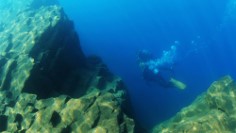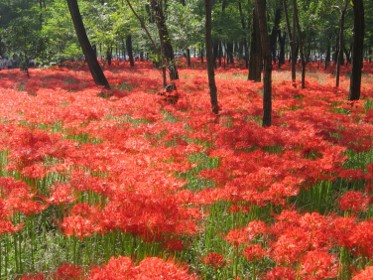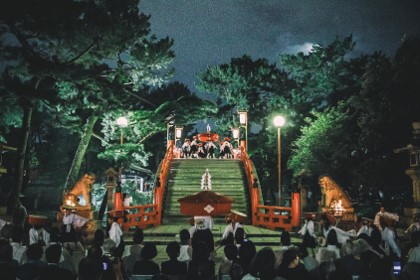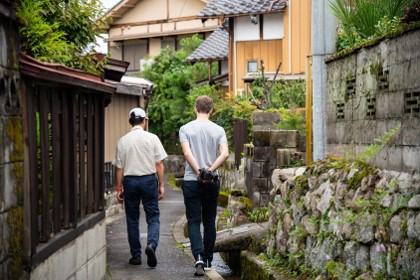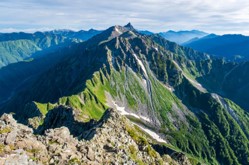
Japan National Tourism Organization (JNTO)
[JNTO] Japan’s National Parks offer immersive experiences in extraordinary environments
2023.09.05
Press release
PDF ver.

In all four seasons, Japan’s national parks showcase the country’s impressive range of wild landscapes and preserved habitats. It’s a precious opportunity to appreciate the distinctive natural beauty of Japan, while encountering native flora and fauna in their natural habitats. Japan’s first three national parks were designated in 1934. Here we will introduce one of them, Kirishima-Kinkowan National Park, as well as noteworthy national parks in the Hokkaido and Chubu regions, along with site-specific activities that are popular in each park.
Hike across the primeval forests of Chubusangaku National Park
May to October is hiking season in Chubusangaku National Park, which encompasses a 3,000-meter-high mountain range known as the birthplace of the “Japanese Alpinism”. Hikers can start by exploring the protected area of Kamikochi, looking and listening for forest creatures as they walk along the clear stream of the Azusa River. As they proceed up the mountain, the panoramic landscape comes into perspective from geological eons of volcanic activity and glacier erosion. This journey traverses a hundred years of mountain culture and history, where hikers might pass an ancient monk’s cave formed by naturally stacked boulders. The hike climaxes at the spearheaded summit of Mt. Yarigatake, where the sun rises dramatically over a sea of clouds.
Further south, a guided nature walk suitable for families explores the unspoiled nature reserve of Goshikigahara Forest in the foothills of Mt. Norikura. This 3,000-hectare forest actively enforces restrictions to protect its natural habitat, including requiring a certified guide to accompany visitors. Trek across a lava plateau, through volcanic ridges and valleys, passing several roaring waterfalls, elusive ponds, huge rocks, giant conifers and deciduous broad-leaved trees in one of Japan’s rarest and most valuable old-growth forests.
Soak in the volcanic steam of Kirishima-Kinkowan National Park
Kirishima-Kinkowan National Park was born in 1934 as Kirishima National Park, which was one of Japan’s first national parks, features diverse volcanic and sea landscapes, including the Kirishima mountains, Sakurajima volcano, and Kinkowan Bay, created by massive calderas. A wide variety of plants grow in the Kirishima area, and various flowers can be observed throughout season. There are also many plants whose names include “Kirishima” such as Miyamakirishima (Kyushu Azalea), Kirishimamizuki (kinds of witch hazel), and Kirishimahigotai (local chrysanthemums). The Kinkowan Bay area has unique scenery centered on an active volcano, Mt. Sakurajima which is a symbol of the area.
On the extreme southern tip of Kyushu’s Satsuma Peninsula, Ibusuki Onsen is famous for its open-air sand baths heated by volcanic steam, which are found nowhere else in the world. This is where visitors can lie down facing the bay in a cotton Yukata, buried up to the neck in hot sand – eyes closed, listening to the waves as the heat of the sand increases the blood flow throughout their bodies. Later, visitors can cook seasonal vegetables and eggs using the volcanic steam from natural geothermal cauldrons at Unagi Onsen by Lake Unagi.
Explore the crystal clear crater lakes of Shikotsu-Toya National Park
Shikotsu-Toya National Park contains the wild splendor of Hokkaido in a geopark of natural wonders and endemic wildlife that is easily accessible from downtown Sapporo and New Chitose Airport. The mesmerizingly circular Lake Toya was formed on a caldera from a volcanic eruption 110,000 years ago. In the center of the lake, Nakajima island consists of a group of lava domes formed from an eruption 50,000 years ago. Within the wider park area, visitors may spot numerous species that represent Hokkaido’s rich wildlife such as Ezo red foxes, alpine hares, and Hokkaido squirrels.
On the eastern side of the park, perched on a caldera formed more than 32,000 years ago, Lake Shikotsu is Japan’s second-deepest and reputedly one of Japan’s most transparent lakes. Visitors can camp out in the camping sites, where diving and kayaking are available. The lake’s famously clear water is home to kokanee salmon and schools of tiny freshwater shrimp. Visitors can explore this unique aquatic habitat through a glass-bottomed kayak.
Discover more active outings at the Adventure Travel World Summit, which will be held for the first time in Asia in Hokkaido in September 2023. The event will showcase a wide range of activities that can be experienced throughout Japan, many within national parks.
Japan Tourism Topics
1. Music lovers’ new haven: stay at the new Hilton Yokohama, opening September 24, Kanagawa
The Hilton Yokohama is set to open in the vibrant Minato Mirai district of Yokohama on September 24th. The hotel will claim its space in the brand-new Music Terrace, a complex hosting the 20,000-seat K Arena Yokohama. Hotel guests can relish in the city's ambiance and the lingering notes of music, courtesy of its floor-to-ceiling windows, showcasing majestic views of Yokohama Bay. What’s more, each room is equipped with high-quality Bluetooth speakers, ensuring a stay enveloped in melodies perfect for all music enthusiasts.
Drawing inspiration from the Art Deco architectural style, synonymous with the era when Yokohama was known as the birthplace of Japanese jazz, guests can witness this motif reflecting throughout the hotel. The Hilton Yokohama offers easy access to Yokohama's main attractions, such as the Yokohama Landmark Tower and Chinatown. Even Tokyo's bustling metropolitan area is just a one-hour train ride away!
Hilton Yokohama: https://www.hilton.com/en/
2. Plunge into a crimson expanse at Kinchakuda Manjushage Park, from mid-September, Saitama
Kinchakuda Manjushage Park, located in Hidaka, Saitama, is a stunning showcase of various flowers, but the real show-stoppers are the red spider lilies (Manjushage). In autumn, these flowers cover the entire park with a layer of rich, deep red, like a vast carpet spread out for a grand, natural performance. This breathtaking scene is one of the most impressive autumn displays in Japan.
From mid-September to early October, the park becomes a magnet for over 250,000 visitors, drawn by these spectacular blooming flowers. The sight of the red spider lilies is complemented by the lively array of stalls of the Manjushage Festival, held from September 16th (Sat) to October 1st (Sun), 2023, offering delicious food, handmade crafts, and local produce, making it not just a feast for the eyes but also a celebration of the season's bounty.
The park, a 22-hectare flatland encircled by the winding Koma River, is a feast of colors that changes with the seasons, making every visit a unique and memorable experience. Being only a little over one hour away from central Tokyo, the area is also perfect for day trips.
Kinchakuda Manjushage Park: https://www-city-hidaka-lg-jp.
3. See a moonlit spectacle at Sumiyoshi Taisha's Kangetsu-sai Festival (Moon-Viewing Festival), September 29, Osaka
On September 29th, Sumiyoshi Taisha transforms into a lunar spectacle as it hosts the Kangetsu-sai. This enchanting moon-viewing festival, Osaka's most representative, coincides with the Harvest Moon and honors the deity of Waka, traditional Japanese poetry, who is enshrined in the sanctuary.
The festival begins with a ceremony at the shrine's main sanctuary, followed by a series of cultural activities set against the backdrop of the rising moon. Visitors can listen to the lyrical recitation of Waka and Haiku poetry, while spectators get a chance to witness the captivating Sumiyoshi dance, performed by children.
The Sorihashi bridge, known for its distinctive arch, serves as the stage for the recitations. Here, both priests and amateur poets alike deliver their verses under the moonlight. This ethereal interplay of poetry, dance, and the moon's glow against the bridge creates an emotionally charged atmosphere that attracts crowds yearning for the beauty of the mid-autumn moon.
Kangetsu-sai Festival at Sumiyoshi Taisha: https://www.sumiyoshitaisha.
4. Explore Japan's earliest autumn foliage at Daisetsuzan Asahidake, Hokkaido
Immersed within Japan's largest mountainous national park. Daisetsuzan Asahidake is known for its splendid autumn foliage. Asahidake is acclaimed as Japan's earliest display of autumn colors. It dons the vibrant hues of fall from late August and reaches its peak around mid-September.
Visitors can easily reach this multi-hued expression of seasonal change. A bus ride from Asahikawa Station leads to Asahidake Sanroku station, where a brief ropeway journey carries spectators to the breathtaking sight of autumn leaves unfurling at an altitude of 1,600m.
Here, visitors are treated to a vision of fall colors sprawling across the landscape. A leisurely stroll around the 1.7km Sugatami Pond Course provides an opportunity for even novices to appreciate the seasonal beauty of rowan trees and Aleutian avens (Chinguruma) shrubs. The area also has more difficult trekking routes. The nearby Asahidake Hot Springs has nine lodging options, three of which allow day trip bathing, completing an all-encompassing hiking experience.
Daisetsuzan Asahidake: https://en.visit-hokkaido.jp/
5. Step into history with a guided tour of Nakatsugawa-juku's timeless back alleys, Gifu
Once a bustling hive of commercial activity, Nakatsugawa-juku is positioned strategically along the Nakasendo, a road constructed over four centuries ago that connected Edo (present-day Tokyo) and Kyoto.
Led by an expert guide, visitors can embark on an immersive two to three-hour journey into Nakatsugawa-juku's captivating history. Every twisting alley is brimming with the recollections of the town's past residents, whose lives and pursuits have left an indelible mark on the town's cultural and historical fabric. Structures preserving the Edo period's ambiance line the streets, offering a stroll that feels like a trip back in time.
The tour uncovers a variety of fascinating locations, including historic buildings and other hidden treasures. The exploration is complemented by an Origami workshop and a visit to a Sake brewery, with a tasting session to savor the local flavors. The itinerary also includes a visit to a well-known Japanese sweet shop known for its chestnut confections. Chestnuts are one of Gifu Prefecture's specialty products, and Nakatsugawa is said to be the birthplace of "Kuri Kinton" (a chestnut-based Wagashi), which is sold in many specialty shops throughout town.
Nakatsugawa-juku Guided Tour: https://nakasendo-walk.com/
Notes:
・ Item 5 is based on information from JNTO Partners.
・ The above details are correct as of the time of publication, and are subject to change.
If you’d like to download photos and videos of Japan's tourist attractions, please visit the Japan Online Media Center (JOMC): https://business.jnto.go.jp/
For media inquiries, including requests to use photographs, please contact the JNTO Press at media_Inquiry@jnto.go.jp








